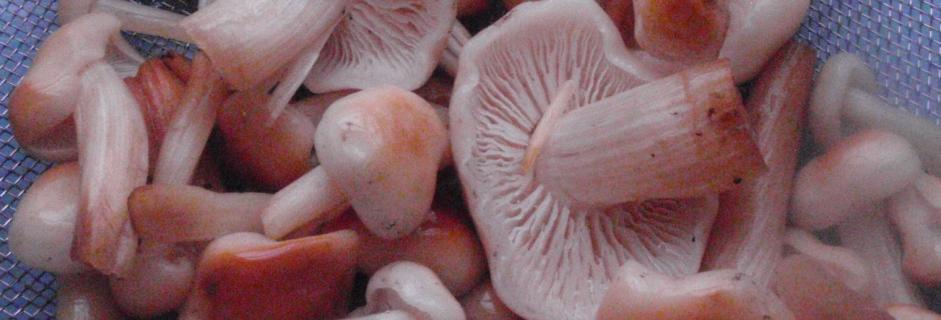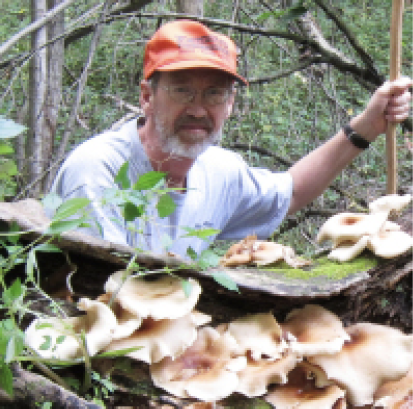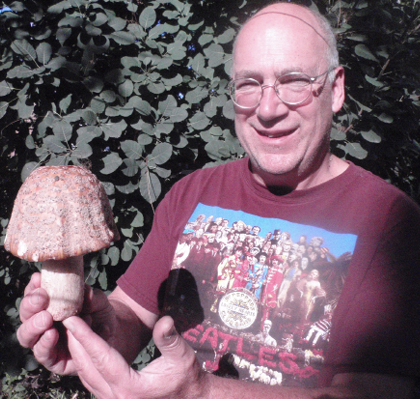The prairie region is a hub for mushroom lovers. As the weather starts to warm up, thousands of Iowans gather their wicker baskets and walking sticks and hit their favorite parks and wooded areas. The Midwest is a goldmine for popular edibles like morels, oysters, and boletes, yet this subculture of mushroom enthusiasts is still underground and unfamiliar to most of the public. For some, mushrooms are an acquired taste and the idea of eating anything that was found on a tree stump is gag-inducing. With the right training and recipes, however, mushroom newbies too can enjoy the delight of finding dinner in the dirt. Many of us don’t know how and where to start looking, and expert foragers are not too keen on giving away their secret mushroom spots to inquirers. However, mycological associations bring together the experienced and the amateurs, so that people with no background in mycology have the opportunity to learn the ins-and-outs of Iowa’s mushroom scene from serious mushroom hunters. To gain some insight into this esoteric Midwestern tradition, the president and vice president of the Prairie States Mushroom Club (PSMC), Glen Schwartz and Dave Layton graciously shared their advice from 13 years in PSMC for those of us who want to know what the mushroom craze is all about.
ROOTSTALK: How did you get started as a mushroom hunter?
SCHWARTZ: I grew up on a dairy farm in north-central Minnesota and we hunted morels every Spring. After I moved to Iowa for my job, I continued to hunt for morels. I still had trouble finding them. Eventually, I figured out that the morels are in different locations: In Minnesota, they are found at the edge of the swamps, while in Iowa, they are in the upland forest. In September of 2005, I was visiting my sister on her dairy farm just a few miles from where I grew up. My brother-in-law and I picked buckets of fall mushrooms from a nearby woods. We had to throw them all out because we could not identify any of them, despite using several mushroom books. A few months later, my friend Roger asked if I was interested in joining a mushroom club, where he serves as treasurer. I jumped at the opportunity to learn more about mushrooms, especially those that appear in the fall.
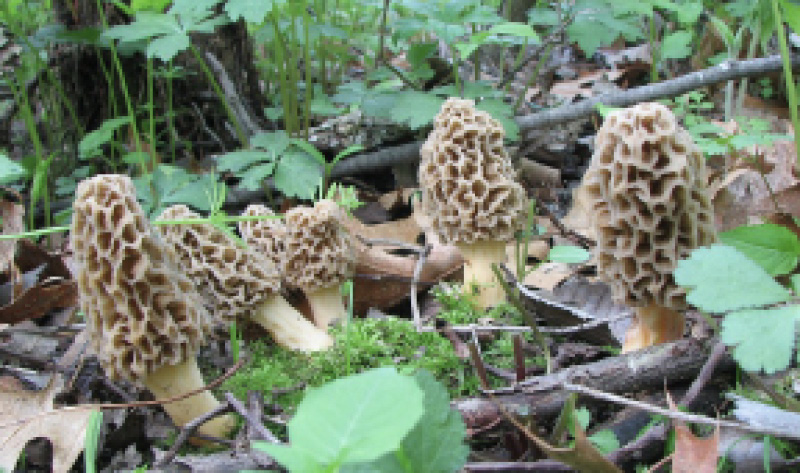
Morels on the forest floor. All photos courtesy of Glen Schwartz
LAYTON: When I was 18 a friend had me try morels and I was hooked. I was also haunted about finding a hillside full of them a couple years earlier with an older friend who just shook his head when I said, “They don’t look edible to me.” I didn’t take any. When I was 19, on a walkabout, I found a nice patch of morels. This time I found a recipe for stuffed morels and cooked them for my family. For a brief time I was a favored son. I wasn’t so lucky in subsequent morel searches, but one time I found these big floppy mushrooms that were tan on top with white gills growing on wood. I got a mushroom book and soon learned they were also a tasty edible—oyster fungus. I fried them with eggs and breadcrumbs. Every time I found a new mushroom I checked out all the mushroom books from the library. Within a few years I identified dozens of species of mushrooms—many of those very tasty.
ROOTSTALK: What do you enjoy about mushrooms?
LAYTON: I enjoy so many things about mushrooms, like the mysteries of their growth and interactions with their habitat or the beauty of their bold shapes against an otherwise drab backdrop. I also enjoy how they turn a walk in the woods into a combination of an Easter egg hunt and a new learning experience. However, what I enjoy most is finding and identifying a new (for me) species. So really what I enjoy most about mushrooms is knowing from experience that somewhere in my future, as long as I keep my eyes open, I’ll find something amazing!
SCHWARTZ: The general population knows almost nothing about mushrooms and fungi, and it doesn’t take much knowledge to become an “expert” in the eyes of most. Before I joined the Prairie States Mushroom Club (PSMC), I knew about morels and giant puffballs, and that was it. Once I joined the club and started looking for mushrooms, they were everywhere! I was amazed at the enormous variety of colors, sizes, and shapes of fungi…and I had never noticed them before. It was like looking through corrective glasses for the first time, and being amazed by how much I could see. Within a few years of joining the club, I was able to make actual scientific contributions. Out on a walk in the woods one day, I found a large quantity of two different mushrooms. One had not been positively identified in Iowa since the 1930s, the other had never been recorded west of the Mississippi River. Turns out, the fungi kingdom has a lot yet to be discovered. The experts are constantly reordering the fungi Class, Family, and Genus, and giving mushrooms new species names based on DNA studies. This indicates that there is much left to learn, and amateurs with no formal training, like me, are able to add to the knowledge base.
ROOTSTALK: What attracts people to mushroom hunting and brings people to forays (group gatherings to pick and identify fungi)?
LAYTON: I could smugly answer that what attracts me to forays is the chance to act like a mushroom know-it-all and scoop up all the edibles left on the identifying table. The truth is that I love seeing so many mushrooms that I wouldn’t have found on my own and I’ve learned more from others at forays than I’ve taught to them. Overall, the same thing brings me to forays as it does the first time novice—the quest for knowledge.
SCHWARTZ: Most of the people of Iowa know of morel mushrooms, and maybe half have actually eaten them. One of our most popular forays is our annual morel hunt at Wickiup Park. We specifically encourage people to attend that have never found a morel before. And most years, we are able to bring them to a place in the woods with morels. Most of them are thrilled to find their first morel, and I enjoy their excitement almost as much as they do. For most people, that is enough. However, there are many outdoor enthusiasts that have observed other mushrooms while out turkey or deer hunting, or during a hike in the woods. Some are curious about what they have seen and if it is edible. Like me before I joined the club, they assume there are 30 or 40 total species to be found, and that anyone leading a foray will know all mushrooms encountered. Once informed that Iowa probably has 10 to 20 thousand species of fungi, a few are fascinated with the idea of finding out more about the mushrooms they have previously found, and learning from local guides.
ROOTSTALK: How can people get started?
SCHWARTZ: Joining a local mushroom club like PSMC is really the key to an enjoyable mushroom hobby. You will learn as much in a single outing with the club as you could learn on your own in a year. You don’t really need much gear, just a pocket knife and a basket. To be safe, however, you will also need a compass (or a GPS unit), long pants, waterproof boots, bug spray, hat, and a walking stick. The stick can be found after you enter the woods, or you can purchase one, or even use a ski pole. Most people don’t bother with a stick at first, but once you start using one, you will realize how valuable it can be. A really high percentage of the mushrooms are found in the woods. Generally speaking, the more mature the woods, the more mushroom species can be found. Having said that, there are also a lot of mushrooms to be found in town. One of our club members even considered writing a book on urban mushrooms. Several years ago, I had three species of slime molds and six species of fungi in my yard at the same time (I live in suburban Cedar Rapids on a typical city lot).
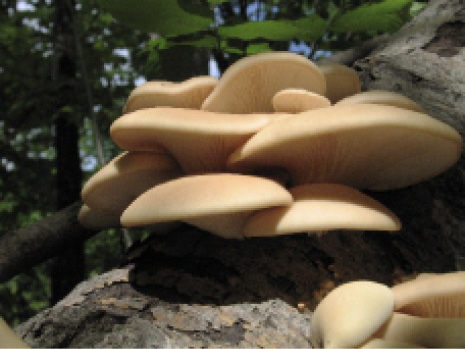
Oyster Mushrooms.
ROOTSTALK: How do people avoid getting poisoned?
LAYTON: Know exactly what each and every mushroom you pick is. Don’t assume that just because mushrooms are the same general color and in the same location at the same time they are the same. There are no rules of thumb! Don’t eat old, desiccated mushrooms of any kind. Know what they’re like fresh.
SCHWARTZ: It is easy for me to avoid mushroom poisoning, as I only eat mushrooms I am certain will be edible. Michael Kuo (who runs the website MushroomExpert.com and is an accomplished amateur mycologist) suggests that you positively identify a mushroom at least three times before you eat it. Last year, I found a Bolete that I had never found before. I consulted several books and multiple websites before deciding to eat them. I was, and still am, certain that I had properly identified them, and they were delicious, but they did give me diarrhea. This brings up the point that, just because a mushroom is known to be edible, does not mean that everyone can eat it without any problems.
ROOTSTALK: Are there any mushroom guides you recommend?
LAYTON: I have at least two dozen mushroom guides. I never use just one to identify a mushroom. I also use the internet once I get narrowed down to one or two genus. Mushrooms Demystifiedby David Arora is probably one of the most comprehensive and he has some pretty witty comments.
SCHWARTZ: I always go to Mushrooms of Northeast North America by George Barron first. This book is organized in a unique way that makes it exceptionally easy to use. It is really geared to the beginner, but it is so good that I always start there. The absolute best guide to edible mushrooms is Edible Wild Mushrooms of Illinois & Surrounding States by Joe McFarland and Gregory M. Mueller. My favorite website is the aforementioned MushroomExpert.com.
ROOTSTALK: How are mushrooms best cooked and eaten?
SCHWARTZ: I am not much of a cook, and I prepare all mushrooms like they were morels…that is, I fry them in some butter and add a little salt. This works for about half of the mushrooms that I have eaten. Unfortunately, I have cooked some “choice” edibles that were not very good because I fried them, and they should have been prepared a different way.
ROOTSTALK: How are mushrooms important to Iowa and prairie culture?
SCHWARTZ: Mushroom hunting in eastern Iowa is extremely popular. In Linn County (Cedar Rapids), I like to say that we have a population of 200,000 and that 150,000 hunt morels. That is a bit of an exaggeration, but when you are two miles from the nearest road and the woods has been stomped flat, you will agree that the number of morel hunters is impressive. In Cedar Rapids, this can be traced back to the large number of Czech immigrants in the 1800s. They brought with them a love of the outdoors and a taste for wild mushrooms. This is still honored today with the Houby Days celebration every May in the Czech Village neighborhood in Cedar Rapids.
LAYTON: We could start with fungi being essential to the existence of all life and try to get more specific from there. Mushrooms signal the health of a habitat. Mushrooms are critical for healthy woodlands where they form a multitude of beneficial relationships with trees and break down dead wood into nutrients for all the forest plants. This is especially important in Iowa where sometimes it seems that trees themselves are endangered. Our remaining parkland is critical to preserve, and mushrooms help to demonstrate the diverse ecology represented in parks and preserves. Corn and beans are great, but we need oak savannas, mixed hardwood valleys and bluffs, trout streams and forest surrounded rivers and lakes if Iowa is going to be a great place to live.
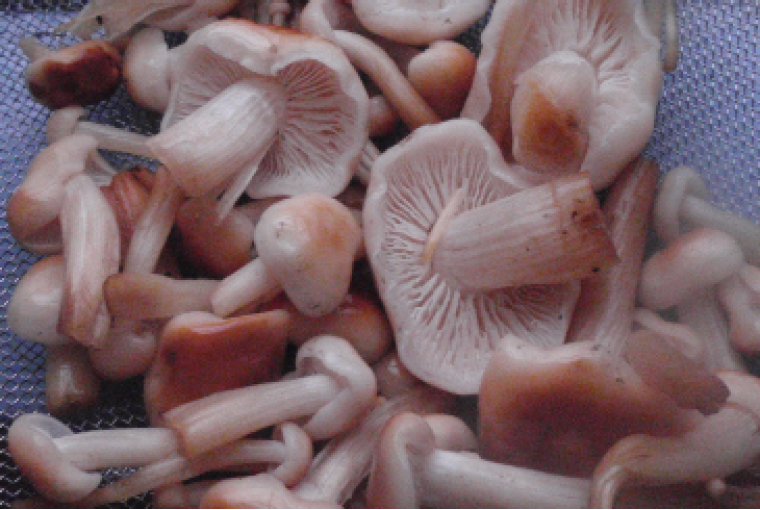
A freshly cleaned batch of enokis.
